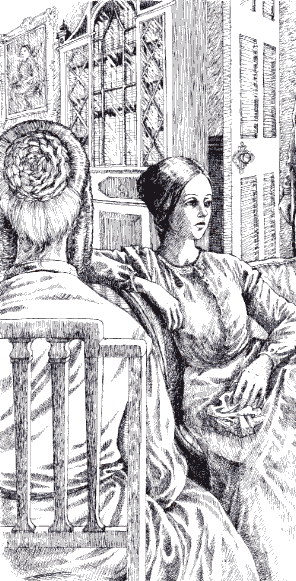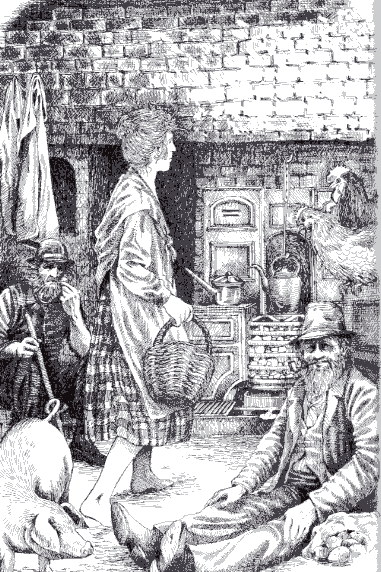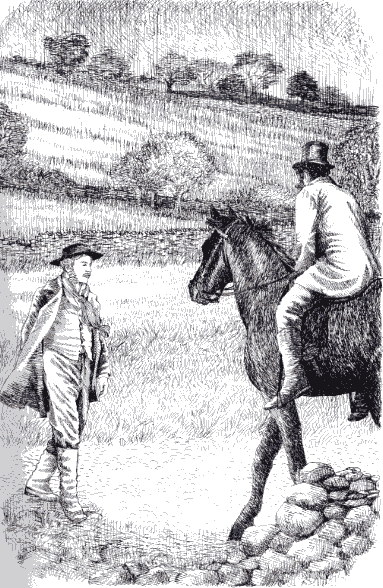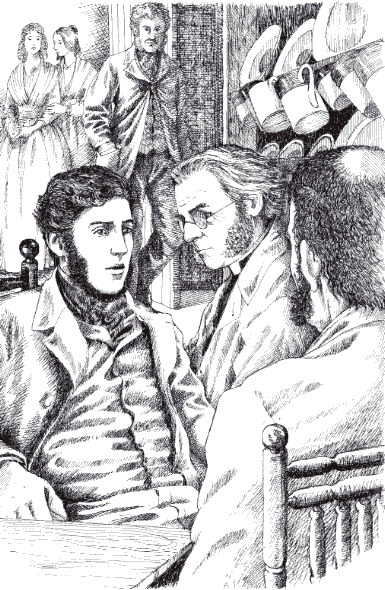

July 7, 2001
Re: Kellys & O'Kellys, Chs 1-5 (or 6): The First Pictures
The Kellys & O'Kellys was not published in instalments, so I am just following the original volume pattern. The Folio Society edition provides three full-page illustrations for Trollope's first five chapters, and three for his second, six for the first volume. They are drawn by Alexy Pendle whose name I have seen before; they are much more detailed, more thoroughly realistic, more carefully shaded and etched than the modern illustrations for the Folio Society Is He Popenjoy?, Ayala's Angel or John Caldigate. The figures or drawings of the people loom much larger, and remind me more of the original 19th century visualisations. All three center on the Michael O'Kelly story.
The first pictures the two Kelly brothers as they walk away from the crowd on the day of the trial. To my eyes the young men are made too gentlemanly, too thin, too young, far too unlined and elegant -- but then that's just what the 19th century illustrators did to Trollope's (and other writer's) texts too. Behind them we see a courthouse (very classical, with columns), a large dome (also classical, rounded, with columns); and another large square building. They walk by a low wall, and Michael (who is pictured with dark hair) has his hand on his older brother's shoulder. There is an eager look in Michael's eye as he talks eagerly; John looks dubious. The caption is "As they walked along the quays, they both discussed the proceedings of the day", and Trollope's narrator goes on to tell us they
expressed themselves positively certain of the result of the trial, and of the complete triumph of O'Connell and his party. To these pleasant certainties Martin added his conviction that Repeal must soon follow so decided a victory, and that the hopes of Ireland would be realised before the close of 1844. John was neither so sanguine nor so enthusiastic; it was the battle, rather than the thing battled for, that was dear to him; the strife, rather than the result (Folio Society Kellys & OKellys, illus Alexy Pendle, p. 13 and facing illustration).
In this coming week's chapter there are a few references to this trial which did not result in an unambiguous triumph at all, nor did Repeal soon follow. The use of the law to intimidate and to bully which we see in Daly and Barry Lynch parallels the government's attempt to intimidate O'Connell and all who supported him. This is a significant device and theme in this book: characters defy and threaten one another, and we see that underneath a veneer of manners what counts is who can win at games of threats (Mrs Kelly doesn't flinch) and who is too soft and sensitive to counter someone else's stonewalling (Ballindine has not the cunning self-control of Blake, the denseness and pragmaticism and loses out against the greed and determination and psychological stupidity of Cashel).
The second illustration is of Mrs Kelly's kitchen:

Pendle has drawn a kitchen with a huge hearth; inside or underneath its roof we see a stove of the type I have seen in museums. It appears to be made of rings of iron inbetween which coals nestle. On top is a large flat very hot surface. In this picture a large pot is sitting there -- cooking something. A square stove sits near that; everything is in brick but the stoves and the floor. The floor is dry mud; the woman at the center again looks too young; she seems slightly too poised. She is barefoot and has a basket; she wears a large shawl over a smock; the smock is over a plaid skirt. She is barefoot; her hair is pulled back into a loose knot. On either side of her sit working men with white beards and weather beaten though respectable clothes. They smoke pipes, wear battered hats. A pig investigates the feet of one of the men; there is a chicken and a rooster near the stove. Trollope's narrator provides several paragraphs of literal description which capture a warm mood; it's a friendly place which produces the food everyone needs despite its abysmal lack of apparent ways to do this. Trollope seems to admire this culture's pluck and resilience as well as the informality and ease of the people. He is truthful about what's not there and manages to be cheerful while telling of how minimal, how crowded, how dark such a kitchen once was. I'll type just a bit of what the picture illustrates:
"it's not that things are out of their place, for they have no place. It isn't that the floor is not scoured, for you cannot scour dry mud into anything but wet mud. It isn't that the chairs and tables look filthy, for there are none. It isn't that the pots and plates, and pans don't shine for you see none to shine: all you see is grimy, black celing, an uneven clay floor, a smal darkened window, oe or two unearthy-looking recesses, a heap of potatoes in the corner, a pile of turf against the wall (p. 43 and falling illustration).
The difference between this description of a kitchen and one in The Macdermots is not that The Kellys slides over the realities of Irish life, but that Trollope presents the truth in a tone of someone slightly amazed to see how people can get on this way. Irish culture is central to this book.
The third picture matches the first in that we have two women walking together: one leans on the other. The caption reads: "As she was leaving the gate of Dunmore House, with Anty on her arm, she was already beginning to repent what she was doing". In some ways this is the most alive of the three: the look in the older, somewhat heavy blonde woman's face (Anty) as she leans on the arm of the grim thinner darker woman (Mrs Kelly) is one of withdrawing back, discomfort, anxiety, uncertainty. Here we have Anty walking forth on the arm of Mrs Kelly, away from the house where beating and murder await her, exploitation, bullying. Yet she is not eager to move forward; she feels some trepidation. Mrs Kelly looks grim as she stares ahead. The two women have shawls; they are plainly dressed with close caps on their heads. They have rings round their eyes; the sky looks like it is just lightening. The house behind them is white, large, not fancy, but substantial; behind them are dark trees, a sliver of a moon in the sky. We are told that Mrs Kelly's feelings of "dubiety" "vanish the moment she had cross her sill" (p. 61), and when Barry comes in, she gives as good as she gets; still the law is apparently on his side. All you need is sufficient unscrupulousness -- which quality is winning out in the state trial.
The pairing of the brothers in a conversation about the state of Ireland and how they really respond to politics; the picture of an inn kitchen; the two women walking unsteadily ahead -- they encapsulate as well as reinforce some of the books concerns: one is the weakness of women in this culture. Lord Cashel may not literally beat Fanny Wyndham, but he attempts to subdue her through strong argments. Like Barry and Martin vis-a-vis Anty, he (and his heir) will want Fanny's property. Mrs Kelly is unassailable in her kitchen, behind her counter, but apparently no where else.
Cheers to all, Ellen Moody
To Trollope-l
July 14, 2001
Re: Kellys & OKellys, Chs 6-10 (or 7-12): Threats, Bargainers, & Insinuations
The illustrations for last week move us away from the Michael O'Kelly characters, and again seem picked to give us a feel for "Irish" life. The theme or paradigm which seems to dominate the book, that of negotiation, of how people interact through continual bargaining and intimidation, through the use of verbal insinuation and hard-ball stonewalling, whereby the weaker, more vulnerable and sensitive go to the wall or simply loss the bargain, and the cunning, stronger, more determined or more powerful (those with the law on their side) is kept up in all three.
This is not deliberate on the illustrator, Alexy Pendle's part: there doesn't seem to be a scene in last or this week's instalment where people are not "at" one another in some way, manipulating, demanding, inveigling -- or, in the case of Anty Lynch and Frank Lord Ballindine who seem oddly paralleled in this book, trying to escape their opponents, in Frank's case, first Lord Cashel, and in Anty's just about everyone, including her suitor, Michael OKelly.
The first illustrator shows us Barry Lynch just after he leave the widow's tavern. The caption is "Barry now took himself off, before hearing the last of the widow's final peal of thunder". We see a youngish man walking off with his face all vexed; he holds his body in a show- offy way, his cane pushed outward; he is puffing himself up with his stomach (covered by a fine waistcoat) firmly forward, his (gloved) hands holding onto a fine outer long coat. But the reader who has just read the scene is not fooled: he had the worst of it. To my eyes the figure of Barry is too thin, not coarse and mean and heavy enough, and the widow in the distance also too thin, too young. They are once again prettied up. The widow is also too sketchily drawn; she is seen in the shadows of her threshold. Trollope does tell us while she is queen over her territories, she is wise enough not to venture beyond them much. Alexy Pendle has, though, gone to much trouble to drawn the front of the shop, its many paned window, a barrel nearby, the cobbled street. We can see goods sitting in the window inside jars and squares and paper packages; through the window from the inside people look out at Barry.
The widow really explodes at
the threat of a legal action. This suggests she is
somewhat frightened, somewhat uncomfortable.
The picture makes us dwell on this explosion
which is opposite it, e.g.,
'God out wid you! You're on good, and never
will be. An' it wasn't for that young woman upstairs,
I'd have the coat off your back, and your face mauled,
before I let you out of the shop!" And so ended the
interview in which the anxious brother can hardly
be said to have been triumphant or successful"
(Folio Society, Kellys & O'Kellys, illus Alexy
Pendle, Ch 6, p. 74 and facing illustration).
We see the violence of Irish life as Trollope felt it.
The sense of this book is that (as opposed to English
life which is probably the contrast in Trollope's mind),
violence is near the surface, easy to provoke into
iruption. It is not buried, repressed, kept back.
She would have had him mauled but that his
sister would look bad and feel bad about it.
Another thing this passage shows us is how often Trollope
links the outward political events to his private characters.
He is continually making quiet little analogies.
I will make a separate posting for each illustration.
Ellen
Re: Kellys & O'Kellys, Chs 6-10 (or 7-12): Threats, Bargainers, & Insinuations
(II)
The second illustration focuses us on one of the many
remarkably portrayed characters in the book: Dot Blake.
We see Frank, Lord Ballindine on the left side of a
horse whose head is at the top center of the illustration.
Frank's face is turned to look up at the eyes of the
horse; he is attempting to control its movement as
it pulls away and up from his hands; he has, as far as
we can see, an open eager expression on his face;
like Barry he has whiskers lining his jaw but the
center of his cheeks are shaven. This must have
been the fashion at the time; his hair is dark (and
is throughout all the pictures of him; he is dressed
not too fancily; a gentleman's coat and trousers,
slightly wrinkled; he has a graceful slender figure. Just behind
his legs is a dog who looks cheerful.
However, we don't notice him at first; what we notice
is the figure whose face is turned frontwards to us;
who is just right of center and leans apparently
carelessly (but it's a posed carelessness) on a pillar.
It's the face that we pay attention to. His eyes are
drawn as tight triangles; Pendle has gotten the hard
guarded expression which is at the same time curiously
neutral, not giving anything away, not emotional, yet
intense. He smokes a huge cigar, carelessly drooping
from his mouth. His hair is blond, wavy around his
head; he wears an elegant well-kept top hat. His
clothing looks very expensive, thick; elegant bow
tie; one his hands, gloved, holds a cane lightly,
pressed to the ground; the other is in his pocket.
There's a slight smile on his face as his mouth turns up.
Yes this is the man who drives the hard bargain in
this week's chapters, who Frank is putty against.
Behind him is another much older man, dressed
in gentleman's clothes which are wrinkled, loose,
have seen hard wear, a slightly shorter top hat;
he has the saddle. The "wall" of the illustration is
the wall of a stable: straw-looking bricks, windows
opened, stalls. The caption is "The sweats and
the gallops, the physicking, feeding and coddling,
kept Frank tolerably well employed". This is a good
example of how the caption cannot compete with
the visuals of an illustration; it is the next paragraph
opposite this picture describing Dot that Pendle
has visualised, though Trollope only provides us
with words about Dot's inward kind of mind, of which
I will type out only a couple of specimen sentences:
"Dot was in his glory, and in his element
on the Curragh, and he was never quite
happy anywhere else (Folio Society, Kellys
& O'Kellys, illus Alexy Pendle, Ch 8, p. 94
and facing illustration). Hitherto -- and I have read this novel at least twice --
I have never paid much attention to Frank Lord
Ballindine; he always seemed to me just an early
fresh sketch of the ne'er-do-well gentleman type we
recently saw in Frank Houston (Trollope does like
the name Frank for this sort of hero -- there's Frank
Gresham, Frank Tregear). However, our slow reading
-- this is the first time I have read the book slowly --
have made me see that Frank in this context emerges
as sensitive, someone with an emotional life he
doesn't quite understand but would make better
if he could; with decent impulses, so decent that
he loses out in the hard-ball nature of this book,
a parallel to Anty, the heroine. Well I like him,
sympathize with Fanny's love for him, her
affection. As I read Johnny Eames, Johnny
can play hard-ball (we see that in his encounters
with everyone but Lily Dale, but especially
other males), but not Phineas Finn: Finn loses
out when pressured on the score of his good
nature and generosity (remember he countersigns
a bill); so too does Mark Robarts. Frank has
his own unique personality, one home-y, but
he relates to these heroes and to me is, along
with Anty, thus far the most sympathetic and
appealing figure in the book -- not the most
interesting or vivid, but the most humanely
appealing.
Now for the parallel heroine. We have already
"seen" Anty being brought to the inn by Mrs
Kelly (the book's third illustration); the sixth
brings us Fanny Wyndham, the "other heiress".
Cheers, Re: Kellys & O'Kellys, Chs 6-10 (or 7-12): Threats, Bargainers, & Insinuations
(III)
The third illustration for this past week's chapters is melancholy
in mood. This melancholy is conveyed by the depiction of a
young woman at the center of it; she looms large in the center
of the picture, sitting very still on a sofa, staring ahead of herself
in the distance, apparently at nothing tangible. Her eyes are large
and and have shadows around them; they look grey; her hair is
tied tightly around her skull as a kind of cap; her dress looks darkish,
not black but grey, very plain.
I have reproduced but one portion of this richly-detailed illustration -- it recalls a number in Ayala's
AngelM and The Last Chronicle of Barset where a room is filled
in with objects. The sofa on which Fanny leans is pillowed
and cushioned, stripes arne colours are seen. To Fanny's
left we see the back of a woman who has blonde hair arranged
in a style I have seen in adaptations of 1840s films which are
historically accurate: the back is a kind of bun in the center
of which the hair twirls; from the side of the head flaps of
hair in the form of curls hang down. We see this from the
back. She is blonde. The dress looks rich. This is Lady
Selina, Lord Cashel's grim daughter who has just been telling
Fanny what "a consolation" it should be to her to think about
how her brother has died so he will not live "to be contamined
by the heartless vices of that portion of the world into which
he would probably have been thrown; he had not become
dissipated -- extravagant -- and sensual [oh dear]. This
should be a consolation to you". Fearing we will laugh too
sharply, Trollope's narrator reminds us the woman means
to be sensible, simply truth-telling and anyway "Fanny
was thinking of something else before she [Lady Selina]
had half-finished her speech" (Folio Society, Kellys
& O'Kellys, illus Alexy Pendle, Ch 10, p. 119 and
facing illustration).
At the right side of the picture, to Fanny's right we see
a sombre old man walking in, he too is richly dressed.
He looks intent and rather dull in his face. He has
a roundish passive face, looks as if he's about to
retreat before you; he too has the whiskers around
his chin with his cheeks shaven; his hair is
retreating (Trollope says he is balding); a bit
plump and as Trollope says pompous in his
bearing. Very elegant long jacket with velvet collar.
He's not as dull as his face looks. Though he's
no reader of other people at all, he wins his
bargains through denseness and determination.
His business in this room is to insinuate and
manipulate Fanny into accepting his rejection of
Frank Lord Ballindine in favor of his appalling son.
Among the many good things about this book is
how real are the vices Lord Kilcullen is given; nothing
emasculated here: real debts, women, hard-core
negotiation is what Kilcullen does with his father,
who Trollope tells us was actually "softer" than his
son. My favorite comic line in this book is Trollope's
about this son's speculations over who he will
be cheating and what he will gain if he marries Fanny:
"the generation was deteriorating" (Ch 11, p. 133)
The caption for this picture is simply "In came the
Earl". It's enough. This is Grey Abbey. As I look
at the picture and think about the scenes, comic
and hard that Trollope's words dramatize for
us taking place in it, I remember Martin Kelly's
statement to Anty: "to tell the blessed truth, I
was thinking av' you too; and that you'd be happier
and asier, let alone betther an' more respectable,
as an honest man's wife, as I'd make you, than
being mewed up there in dread of your life ..."
(Ch 15, p. 180). Fanny is not in danger of her
mortal life, just her happiness is at risk, that's
all, and she too would be better off with Frank.
Good parallel plotting enables the reader to
apply important statements from one plot to
the other.
Cheers to all, To Trollope-l
July 21, 2001
Re: Kellys & O'Kellys, Chs 11-20 (13-22): Irish Landscape & Male Encounters
Last and this coming week's instalment have but one
picture each in the Folio Society edition and they
both place dramatic scenes of physical interactions
between males at their centers. If there is such a
thing as a novel dominated by male spirit, and one
dominated by a female, this is one where scenes
between males take up most of the action. When
males are not dominant, they accompany, threaten,
attempt to manipulate, or soften a female. It is
also a novel where Trollope seems intently taken
up with Irish culture, the Irish milieu: Trollope
makes a point of contrasting Daly's office with
an analogous scene from a typical English
attorney's office as he did Mrs Kelly's kitchen
with a typical middle class Englishwoman's
kitchen. Here we have a picture of what
loks like a green damp rich landscape, and
a picture of the Irish hunt run by Frank,
Lord Ballindine.
The caption for the first illustration is: "'And is
that all you called me back for?'":
This scene visualizes a key conflict
in the novel: Barry v Michael OKellys
is also paralleled with Lord Cashel
Frank, Lord Ballindine (Folio Society
Kellys &OKellys, illus. Alexy Pendle,
Ch 15, p. 174 and facing illustration).
The caption for the second illustration is:
"And now the business began". This coming
week's chapters end in a hunt: the hunt
among the Anglo-Irish and Irish establishment
in Ireland was perhaps more important as
a class and leisure element than it was
to the English in England. Trollope says
as much in his An Autobiography, and
in The Landleaguers we see that the
tenants see in it a symbol of their oppression,
exploitation, the advantage taken of them,
and central to their boycott is their taking
to the fields to prevent landlords from
hunting. The subtitle of The Kellys
& O'Kellys is Landlords and Tenants,
though in this early book relationships
between these two sides as such are
harmonious; it's people who don't
fit in, the overly corrupt (Kilcullen),
and the vicious, ruthless and spitefully
coarse (Barry) who are to be ejected.
By tomorrow all those who are reading
along by the schedule will know that
Barry is another of Trollope's "inferior"
gentleman to show himself to be
not worthy, below others, by mismanaging
a horse and causing the death of an
animal.
The scene is one I have seen in countless
paintings and prints: the English gentleman
on horses in their resplendent or relaxed
riding outfits, the large handsome and
elegant horses, dogs surrounding them;
in the left background a large house; to
the right a wood (Ch 20, p. 231 and
facing illustration).
Cheers to all, From the second half of the novel a typically tense scene between the males, Chapter 31 (facing p. 370): "The three of them ent up into the little parlour of the hotel, and summoned Martin to the conference . . . ":"He took very good care that he was never
charged a guinea, where a guinea was not
necessary and that he got a guinea's worth
for every guinea he laid out ..."
Ellen

Ellen Moody

Ellen Moody

Home
Contact Ellen Moody.
Pagemaster: Jim
Moody.
Page Last Updated 11 January 2003